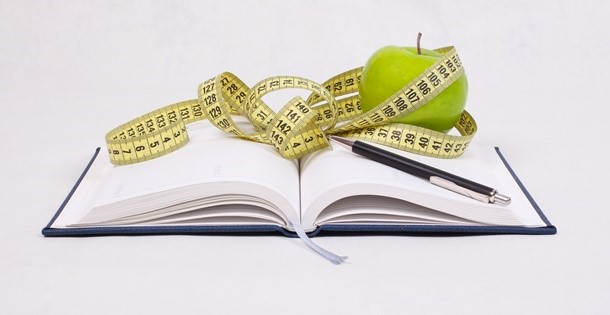We are pleased to bring you this regular column by Dr. David Creel, a licensed psychologist, certified clinical exercise physiologist and registered dietitian. He is also credentialed as a certified diabetes educator and the author of A Size That Fits: Lose Weight and Keep it off, One Thought at a Time (NorLightsPress, 2017). See all of David Creel’s articles here.
Do you have a weight loss question for Dr. Creel? Email him at [email protected]. He may answer your question in a future column.
Creating and maintaining a food diary is one of the best ways to increase awareness of what you’re doing. A food journal is to an overweight person as a speedometer is to a speed demon trying to slow down.
If you dread the idea of having a paper journal you must pull out each time you eat, hide for fear someone might look at, or misplace multiple times a day, you can relax and let technology eliminate these barriers. A multitude of apps allows us to discreetly track eating and physical activity. It’s as simple as pulling out your phone and entering a little information each time you eat. Many of the applications have features that allow you to scan the UPC code of a food in order to add it to your diary. At all times during the day you can see how many calories you’ve eaten and how many remain, which will guide you during situations like that late-night trip to the refrigerator. You can also pay attention to other dietary factors such as percent of calories coming from fat, protein and carbohydrate, the grams of fiber you have consumed, and so on. If you aren’t into technology, there’s no reason you can’t keep a paper food journal. Many of my patients prefer this simple pen-and-paper method. If you’re working with a professional to manage your weight, a food journal highlights the strengths and weaknesses of your diet, and can guide the discussion about your eating patterns.
Tracking food intake will help you pay attention to what you’re eating, educate you on the source of calories, allow you to examine patterns of behavior you may want to modify, and help explain why your weight is changing. Whether you use a paper journal, an app, or a website to track your eating, the following suggestions will help you get the most out of self- monitoring.
1. Include everything you eat
The primary goal of keeping a record is to increase awareness and ultimately change your behavior. Therefore, you should “partner” with your journal, agreeing to report everything you eat. That includes a handful of peanuts, a small piece of candy, a bite of your spouse’s cake, etc. Having incomplete or inaccurate food records will frustrate you, because according to the records, you should be losing weight, but aren’t. Yes, it’s a bit inconvenient to record every little thing you put in your mouth, but therein lies the beauty of self-monitoring. It can cause you to pause and ask yourself, “Do I really want these peanuts if I have to record them? Am I really that hungry?” If you’re eating out of habit, your food journal is a deterrent to mindless eating and grazing.
2. Include all beverages containing calories
Many people who record their intake are lackadaisical about including beverages. Soda, juices, alcohol, sport drinks, and even some diet beverages contain calories and can be a significant contributor to weight.
3. Measure your portions
Although researchers have developed a way to determine portion sizes by taking photos of our food, there is currently no good, commercially available technology to track portion sizes without some work on your part. Weighing and measuring food can be helpful because our eyes fool us into believing we’re eating less than we really consume. Although a food label may list ¾ cup of cereal as a serving, that may not be typical for you. Once you determine how much a cup of milk fills your glasses, what one cup of pasta looks like on your plates, and the size of three ounces of meat (about the size of a deck of cards), you may not need to get the measuring cups and food scale out for each meal. However, spot-checking portion sizes is generally a good idea to make sure your perception isn’t drifting. If you aren’t losing weight as expected, returning to exact measuring may be helpful.
4. Include the good days and the not-so-good days
We often learn more from our struggles in life than we learn from success. Although it’s psychologically challenging to record food intake when we feel as if we’re going off the rails, this can be immensely helpful. Tracking deviations helps reveal our relationship with food. Behavior is easier to correct when we’re aware of food-related triggers and typical responses. For example, perhaps you overeat when dining out with friends or after a stressful day at work when you feel too tired to cook. People who pay attention to these trigger events usually get off track less often and stay off track for shorter periods, compared to those who feel discouraged, stop being mindful, and abandon the food journal.
Food journaling is part of a larger process of changing your relationship with food. In order to get the most out of it, you need to reinforce healthy behavior, but also understand and change your unhealthy responses to stressful situations.
5. Record as you go
Record the foods you eat as you eat them. Waiting until the end of the day to write down what you’re doing is like waiting until you get your credit card statement to determine if you’re sticking to a budget. Tracking as you go leads to awareness. You are self-monitoring your behavior rather than just producing a record. In addition, the longer you wait to record your intake, the more you misremember what and how much you ate. It’s easy to forget exactly what you consumed, and portion sizes tend to shrink when you rely on memory.
6. Tell a story
Your food journal should tell a story. When you’re losing weight it should be evident why this is occurring. Remember, it takes approximately a 3,500-calorie deficit to yield a pound of weight loss, so we aren’t looking at food records to explain day-to-day changes in weight. Rather, we can examine eating patterns over several weeks to explain weight changes. If the numbers don’t add up, look for sources of error in your reporting.
I’ve often reviewed patients’ food journals that indicate they eat less than 1,200 calories per day, yet aren’t losing weight. Sometimes patients attribute this lack of weight loss to a slow metabolism, decreased physical activity, or having a Martian-like physiology that defies the laws of thermodynamics. But the true reason is usually based on inaccurate reporting. The most common errors come from waiting too long to record intake or failing to weigh and measure food. Other patients may be eating a lot of unknown calorie foods. They may frequently stop at a mom-and-pop diner for lunch, and although they do their best to determine portion sizes and calories, they really don’t know what’s in the food. Lastly, people using electronic apps make mistakes by selecting foods from the database that don’t match what they actually consumed.
7. Consider the peculiar
Spray margarine is a great way to get the flavor of butter without the calories. The primary ingredients are water and oil. If you look at the food label it indicates “0” calories. In fact, it does have calories because it contains oil. But the serving size is “one spray” and rounding the calories of one spray to the nearest digit allows the manufacturer to indicate it has no calories. I’ve never seen anyone stop after one squirt, but nevertheless, it’s a lower-calorie alternative to other added fats.
Tammy, who liked the taste of butter but didn’t want the consequences of calories, was an avid food label reader and decided to use spray margarine. In her eyes this was a “free food” because the label clearly read it had zero calories. Since it was calorie-free, she didn’t bother putting it in her food journal. Due to great investigative work by one of our registered dietitians, we were able to solve the mystery of why Tammy was gaining weight; she consumed up to two bottles of spray margarine every day. She would take off the spray top and pour it on almost everything she ate. This gross-me-out use of spray margarine obviously contributed to her unexplained weight gain.
Another client asked me if she needed to include sugar-free gum in her food journal. My first response was “no.” Sugar-free gum only has five calories per stick and the act of chewing gum actually burns a few calories and may prevent someone from mindlessly eating snacks. To me, the calories in the gum were a wash. But as we continued to talk, I began to understand she really liked gum. In fact, she was compulsive about chewing it. She was an ex-smoker who used gum to deal with anxiety. She would chew a piece of gum just long enough to get the sweet taste from it, and then she would spit it out and get another piece. She was going through five or six of the 10-piece packs per day. She consumed enough sugar-free gum every day to equal the calories in two regular sodas. Although her breath was always great, she wasn’t adequately handling the stress of work. She had a good sense of humor about her gum issue but realized this compulsive chewing was contributing to the problem with her weight. We worked together to help her manage stress in better ways.
8. Remember the spirit of the food journal
The goal of keeping a food journal is to become more aware of your relationship with food, which will help you establish healthy eating habits that lead to weight loss or maintaining a healthier weight. Most people, even those who are successful, don’t use the journal every day for the rest of their lives. However, self-monitoring your diet regularly in the early stages of weight loss is extremely important in order to learn more about your eating patterns and educate yourself on where, when, and under what psychological or environmental circumstances you consume extra calories.
Over time you may decide to only record your food during the times you struggle most, such as evenings or weekends. You may eventually stop recording everything you eat and simply have a daily checklist. Others have successfully used food journaling in tandem with self-weighing, only recording their foods when weight begins to climb.
Come back each week for more healthy weight loss advice from Dr. David Creel.
Become a Saturday Evening Post member and enjoy unlimited access. Subscribe now



